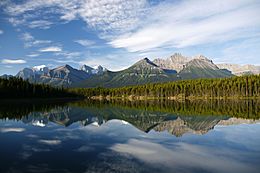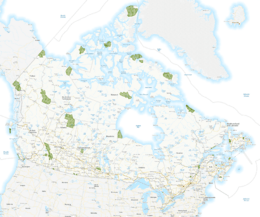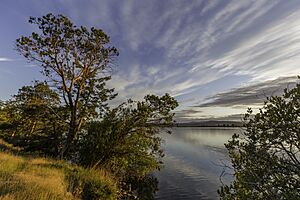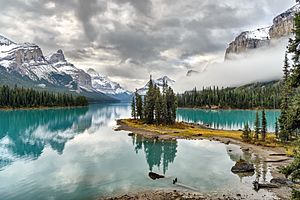National parks of Canada facts for kids
|
National parks of Canada |
|
|
|
|
| First park | Banff National Park, 1885 |
| Smallest park | Georgian Bay Islands National Park, 13.5 km2 |
| Largest park | Wood Buffalo National Park, 44,807 km2 |
| Governing body | Parks Canada |
National parks of Canada are huge natural areas across the country. They are protected by Parks Canada, a special government group. Parks Canada looks after these parks and reserves. Their job is to teach visitors, keep them safe, and make sure everyone can enjoy these places. They also make sure the parks stay healthy for people in the future.
This protection includes looking after Canadian wildlife and their homes inside the parks. Parks Canada also manages other protected places. These include National Historic Sites (important historical places), National Marine Conservation Areas (NMCAs) (protected ocean areas), and national park reserves. Canada started its first national park in Banff in 1885. Now, there are 37 national parks and 10 national park reserves.
Contents
How Canada's National Parks Began
Canada's first national park was created in Banff in 1885. At first, these parks were mainly about tourism and making money. People also took natural resources from them. The idea was to use the parks to help Canada's economy, but also to save nature for everyone to enjoy later.
Sometimes, when new parks were made, people living in those areas had to move. This included both Indigenous and non-Indigenous families. To solve these problems, Parks Canada started working with local communities. This "co-management" helps keep the park's nature healthy.
A big change happened in 1930 with the National Parks Act. This law focused more on keeping natural areas untouched and healthy. It moved away from just making money. Canada's national parks are now symbols of the country. They are found in every province and territory, showing off Canada's amazing natural beauty.
Important Dates for National Parks
- 1885 – Banff National Park becomes Canada's first National Park. It was first called the Banff Hot Springs Reserve.
- 1908–1912 – Four national parks are created in Alberta and Saskatchewan. They were like wildlife refuges and were later closed when their goals were met.
- 1911 – The Dominion Parks Branch is created. This was the world's first national park service. Today, it is known as Parks Canada.
- 1930 – Canada's government passes the first National Parks Act. This law helps protect the parks.
- 1964 – The first National Parks Policy is put into place.
- 1970s – The National Parks System Plan is made. Its goal is to protect a part of each of Canada's 39 natural areas.
- 1979 – The National Parks policy is updated. It makes protecting nature the main goal in Canadian Parks.
- 1984 – The first national park is created because of a land claim agreement with Indigenous people.
- 1988 – The National Parks Act is changed. It officially makes "ecological integrity" (keeping nature healthy) a key rule for parks.
- 1989 – The Endangered Spaces campaign starts. Groups like the Canadian Parks and Wilderness Society work to finish the national parks system. They want parks to represent all of Canada's natural regions.
- 1998 – The Parks Canada Agency Act is put into action.
- 2011 – To celebrate 100 years of national parks, Parks Canada creates the National Parks Project. This project makes documentary films about different parks.
- 2017 – Parks Canada offers free entry to national parks for the whole year. This celebrates Canada's 150th birthday.
- 2019 – Thaidene Nëné National Park Reserve is created. It is Canada's newest national park.
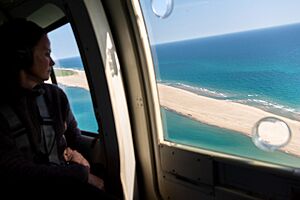
How Parks Were Created and Grew
On July 20, 1871, British Columbia joined Canada. As part of this, Canada agreed to build a railway across the country. When railway workers explored the land in 1875, they found many natural resources. This led to mining and using resources in Canada's wild areas.
Workers found hot springs near Banff, Alberta. In November 1885, the Canadian Government made these springs public property. This stopped private companies from taking them over. This was the start of Canada protecting land for public use as national parks. By the late 1880s, Thomas White, a government minister, began working to create Canada's first national park in Banff.
In May 1911, an important law was passed: the Dominion Forest Reserves and Parks Act. This law created the first group to manage national parks, called the Dominion Parks Branch. Today, this group is Parks Canada. With this group in place, the park system grew from Banff towards the east. It aimed to both use and protect the land.
The main reasons for creating national parks in Canada were to make money and to protect nature. Canada was inspired by the success of Yellowstone National Park in the United States. Canada mixed the ideas of saving nature and making money. This helped meet the country's need for resources and also pleased people who wanted to protect nature. Many people also wanted to enjoy the outdoors and "get back to nature."
This growing interest led to the idea of saving Canada's wild areas by creating public parks. Canada relies on its natural resources. So, national parks became a way to balance making money from the land and tourism with the need for preserving nature and using resources wisely for the future.
At first, groups that wanted to protect nature were important. But groups focused on business and tourism also played a big role. They pushed for parks to be developed for profit. They also included wildlife protection when they could. Canada's national parks gave people a way to experience nature. They also helped save Canada's beautiful landscapes and wildlife during a time of much development.
Tourism and Making Money
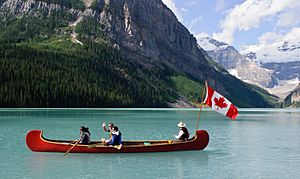
When more people visited national parks, it helped them grow faster. To get more people to visit, groups around the parks pushed for better roads. This included building the Trans-Canada Highway. This main highway goes through the Canadian Rockies. It made it easier for people to visit and for businesses to grow. The highway has many places to pull over and have a picnic. With more travelers and places to stop, tourism grew a lot after the highway was built. The highway goes through Banff and the Bow Valley area. It offers amazing views of the mountains and lots of wildlife.
With more tourists visiting Rocky Mountain Park, the town of Banff grew. The Banff hot springs became easier to reach after a tunnel was built in 1886. Horse-drawn carriages were replaced by buses and taxis. By the 1960s, small cabins were mostly replaced by hotels. Banff became a place focused on tourism. In 1964, the first visitor center opened at Lake Louise Station. It included a campground and other attractions.
The Cave and Basin Springs had to rebuild their bathing pools in 1904 and again in 1912. This was because more and more people wanted to use the hot springs. By 1927, campgrounds at Tunnel Mountain were updated to fit trailers as well as tents. The campground was made bigger due to high demand. By 1969, it was the largest campground in the national park system. Banff became a year-round fun spot. Winter sports like skiing also brought more tourists. Ski lifts helped Banff become a popular place for skiing and winter activities.
Problems When Parks Were Created
Using Natural Resources
From the very start, making money was a big part of creating Canada's national parks. Tourism was the first way to make money. But then, using natural resources like coal, lumber, and other minerals became another main way to earn money. These resources were found in large amounts in the Rocky Mountains. People thought there would always be enough.
Coal was the most common and profitable mineral. So, mining coal in parks was allowed by politicians and the Canadian Pacific Railway (CPR). For example, Bankhead, a coal town, was built on the road to Lake Minnewanka. This coal town was not seen as bad for the beauty of Banff National Park. Instead, it was seen as an extra attraction for visitors. In this case, using resources and tourism worked together to make the park more profitable. But it was clear that making money from resources was more important than tourism.
The resources taken from the national parks were very important for the CPR's income. The railway carried these resources across the country. In 1887, the Rocky Mountains Park Act was created. This law showed how important using resources was for Canada's economy. Under this rule, national parks were not fully protected in their natural state. Mining, logging, and grazing were still allowed.
When the Rocky Mountains Park Bill was suggested, some people criticized it. They pointed out that using resources inside a national park seemed to go against protecting it. However, at that time, many people believed that logging and mining would make the park more useful, not less. They thought the natural resources in the parks were endless. So, they should be used if it helped the country's economy.
By 1911, Canadians started to worry about resources running out in America. This led to a debate about how much resources should be used in Canada's national parks. This discussion began in 1906 at a meeting in Ottawa. It sparked new interest in "conservation" (protecting nature). This interest spread to the government, scientists, and the public. Canada's national parks were no longer seen as places with endless resources. Now, people thought resources needed to be protected through rules to make sure they would be there for the future.
J.B. Harkin, the Parks Commissioner in 1911, wanted to stop all coal and mineral mining in the parks. But his idea didn't happen until 1930, when the National Parks Act was passed. This act banned mineral exploration and development. Only limited logging was allowed. To keep Canada's economy strong through resource use, the borders of Canada's national parks were changed before the 1930 Act. This was done to remove areas rich in resources from the park boundaries. Stopping resource development in Canada's national parks was a small step towards protecting them more. But recreational use and development were still allowed.
People and Park Creation

The first idea for national parks was that they were wild places with no people. To create this, Indigenous and non-Indigenous people who lived inside the park boundaries had to move. Also, rules were put in place about how these people could use the land and resources for their survival.
Jasper National Park, created in 1907, limited activities that earned money, like hunting. It also limited cultural practices of Aboriginal groups who had used the area. Jasper is a large park in a southern, often visited part of Canada. It is one of many parks made more for tourism than for pure protection. Most parks are designed to look like untouched wilderness. But they also have facilities and roads for visitors. Human activities were allowed in the park, but mostly only those that made money, like snowboarding and hotels for tourists. Some people said that the choice of what activities to allow favored non-native people. This is because it stopped traditional ways of life like hunting and trapping.
Parks in less visited, northern parts of Canada were created with more thought for Aboriginal ways of life. Kluane National Park and Reserve in the Yukon first had hunting limits to protect wildlife. So did Ivvavik National Park in the Northern Yukon. Through local groups and political efforts, Indigenous people in these areas had more say in how parks were created. For both Kluane and Ivvavik parks, Indigenous groups protested and spoke to government committees. They explained how these rules stopped them from providing for themselves through traditional fishing, hunting, and trapping.
Ivvavik National Park, created in 1984, was the first in Canada made through a land claim agreement. This set a new example for working together in future parks. In June 1984, the Inuvialuit Final Agreement was signed. This agreement was different from past parks. It included more Aboriginal interests. It gave the Inuvialuit special rights to hunt and harvest animals within the park. This agreement was an example of "co-management." It made sure Indigenous voices were heard and had equal say on park boards.

Non-Indigenous groups also lost their land when national parks were created. An example is the Acadians of Kouchibouguac National Park in New Brunswick. This park was created in 1969. It recognized the Aboriginal groups who had lived there. But it did not recognize the Acadians. About 85% of the more than 1,500 people who had to move to create the park were Acadian. Many people who lost their land fought back against Parks Canada. The Acadian people's resistance was so strong that it delayed the park's official opening until 1979. Through protests, they won more money from the government. This helped make up for losing their main source of income, which was fishing in the park. The Acadians' resistance affected how future parks were created. In 1979, Parks Canada announced it would no longer force people to move for new parks. In 2008, Parks Canada created a committee to look back at the Kouchibouguac situation and address any remaining complaints.
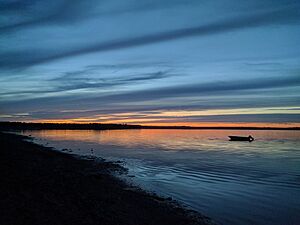
Changing Ideas About Park Management
Conservation Efforts
In the late 1800s, Canadians started to change how they viewed nature and resources. Opinions began to focus on "conservation" ideas. They moved from thinking that nature and resources were endless to seeing them as limited.
The Commission of Conservation was created in 1909. It became the main group in Canada for conservation issues. It gave advice and answered questions about how to better use Canada's natural resources. The Commission focused on a plan to get the most future profit by managing resources well now. Instead of just saving resources by not using them, the commission wanted to manage them for long-term gain.
Other groups focused on conservation, like the Alpine Club, had different ideas. They wanted to protect natural wilderness and were against any building or development. This movement was successful. Parks created only for protection, like the bird sanctuary in Point Pelee, began to appear. To push their ideas further, this movement, led by James B. Harkin and Arthur Oliver Wheeler, had to argue that beautiful scenery itself could make money through tourism. This helped them push aside what they saw as a much bigger problem: taking too many resources. By 1930, even conservation groups in Canada understood that the country's national parks had a strong focus on making money.
The Parks Canada Agency Act started in 1998. It was put in place to make sure parks are protected for future generations. It also recognized them as important places for culture and history.
Keeping Ecosystems Healthy
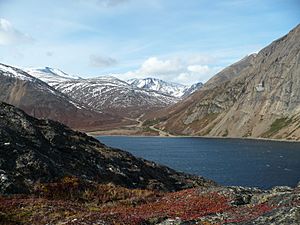
Parks Canada says that a healthy ecosystem has three parts: non-living things (like rocks), living things (like plants and animals), and natural processes (like how water flows). When all three parts are healthy, the ecosystem is healthy. Ecosystems in national parks have often been harmed. This is due to using too many resources, too much tourism, and land use outside the parks.
Parks Canada realized that people needed to manage national parks to keep them healthy. So, Parks Canada started to focus on "ecological integrity" (keeping nature healthy) in national parks. This was a shift from focusing on profit to focusing on protection.
This change in values came from the 1930 National Parks Act. This act limited how resources could be used for park management. Then, in 1979, the updated National Parks Policy made keeping ecosystems healthy the top goal for protecting Canada's national parks. In 1988, the National Parks Act was changed again, and the rule about ecological integrity became official. However, because of the conflict between making money and protecting nature, progress on keeping ecosystems healthy has been slow.
A big push to keep ecosystems healthy started in 2001. The Canada National Parks Act of 2001 made it even clearer that keeping and restoring healthy ecosystems was important. It set new rules for how parks should be managed. Wild areas in Banff, Jasper, Yoho, and Kootenay National Parks were officially named wilderness areas. The borders of all towns in national parks were changed. New businesses in these towns were limited. Making money was no longer the main goal. Instead, protecting nature through healthy ecosystems became more important.
To keep or restore healthy ecosystems, parks are working to bring back damaged ones to their original healthy state. For example, Grasslands National Park brought back Bison bison (buffalo) to help restore the prairie. The way bison graze helps keep many different kinds of plants and animals healthy on the prairie. In Gwaii Haanas National Park Reserve and Haida Heritage Site, staff are removing Norway rats. These rats were accidentally brought to the area. They eat eggs, young birds, and adult seabirds, which reduces the seabird population. Park staff check for rats and use traps to help native seabird populations recover.
Working Together (Co-management)
Through park rules and how they operate, Parks Canada has learned how important it is to work with Indigenous peoples and other communities. This helps manage the healthy ecosystems both inside and around national parks.
In 1984, Ivvavik National Park was created because of an Aboriginal land claim agreement. Now, Ivvavik is managed together by Parks Canada and the Inuvialuit people. Their shared goals are to protect wildlife, keep the ecosystem healthy, and protect their cultural resources. They also make sure the Inuvialuit can continue their traditional ways of life, like trapping, hunting, and fishing.
Another example is Torngat Mountains National Park. It was created in 2005 because of the Labrador Inuit Land Claims Agreement. This park protects the rights of the Labrador Inuit in Canada. These rights include land, resources, and self-government. The government also signed an agreement with the Inuit Association. Like the Ivvavik agreement, it makes sure that the Inuit can keep using the land and resources for their traditional activities. It also protects their special connection with the land and ecosystems. They also agreed to manage the park together. A special board with seven members will advise the government on how to manage the park's environment.
Parks Canada now understands the knowledge of Indigenous people. They also understand their special history and cultural connection with the land. Because of this, Parks Canada started to work with Indigenous people to manage parks. After 1985, new national parks or national park reserves began to be created. These include Aulavik, Nááts’ihch’oh, Tuktut Nogait, and Thaidene Nëné in the Northwest Territories. Qausuittuq, Quttinirpaaq, Sirmilik, and Ukkusiksalik in Nunavut. Akami-Uapishkᵁ-KakKasuak-Mealy Mountains and Torngat Mountains in Newfoundland and Labrador. Sable Island, Nova Scotia. The Bruce Peninsula and Rouge in Ontario. Wapusk, Manitoba, and Gwaii Haanas and Gulf Islands in British Columbia.
Growing the Park System
Future National Parks and Reserves
All existing national park reserves are planned to become full national parks. These include:
- Gwaii Haanas
- Gulf Islands
- Kluane (part of this park is a Reserve)
- Mealy Mountains
- Mingan Archipelago National Park Reserve
- Naats'ihch'oh
- Nahanni
- Pacific Rim
- Sable Island
- Thaidene Nëné
Other areas have been suggested as parks or reserves. They have been studied and discussed by different groups. These include:
- Pitaweikek in Prince Edward Island (as a National Park Reserve).
- South Okanagan-Similkameen in southern British Columbia (as a national park reserve).
Parks Canada is also thinking about other areas for future national parks:
- Manitoba Lowlands (north-western Lake Winnipeg)
- Making Waterton Lakes National Park in Alberta bigger to include the Flathead Valley in British Columbia (as a national park reserve)
Marine Protected Areas
National Marine Conservation Areas (NMCAs) are a newer type of protected area. There are currently three NMCAs:
- Fathom Five National Marine Park, Ontario
- Lake Superior NMCA, Ontario
- Saguenay–St. Lawrence Marine Park, Quebec
Fathom Five National Marine Park and Saguenay–St. Lawrence Marine Park were created before the NMCA idea. They were later called NMCAs without changing their names. NMCAs have a different purpose than land parks. They are designed for sustainable use, meaning people can use them carefully. But they also have areas to protect nature.
Like national park reserves, National Marine Conservation Area Reserves are meant to become full NMCAs once land claims are settled. There is currently one NMCA Reserve:
- Gwaii Haanas National Marine Conservation Area Reserve and Haida Heritage Site, next to the national park reserve of the same name, in British Columbia.
Two areas are being considered as a National Marine Conservation Area or NMCA Reserve:
- Southern Strait of Georgia NMCA Reserve, in British Columbia. This area surrounds Gulf Islands National Park Reserve. A study is being done to see if it's possible.
- Tallurutiup Imanga NMCA, in Nunavut.
Special Natural Landmarks
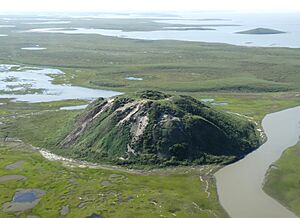
Besides national parks, a "National Landmarks" program was planned in the 1970s and 1980s. But only one has been created so far. Landmarks were meant to protect special natural features. These features would be "outstanding, unique, or rare to this country." They would usually be single, important natural sites that are interesting for science.
To date, only one Landmark has been created: Pingo National Landmark in the Northwest Territories. Another was suggested at the same time (1984): Nelson Head National Landmark. This was planned for the southern tip of Banks Island, also in the Northwest Territories. It was meant to cover about 70 square miles (180 km²) and 25 miles (40 km) of coastline. It would protect the sea cliffs at Nelson Head and Cape Lambton. The Durham Heights, which reach 2,450 feet (747 m) high, were also to be included. The law for this Landmark said that the Minister of the Environment had to make a formal request within 10 years (until 1994). But no request was ever made.
See also
 In Spanish: Parques nacionales de Canadá para niños
In Spanish: Parques nacionales de Canadá para niños


